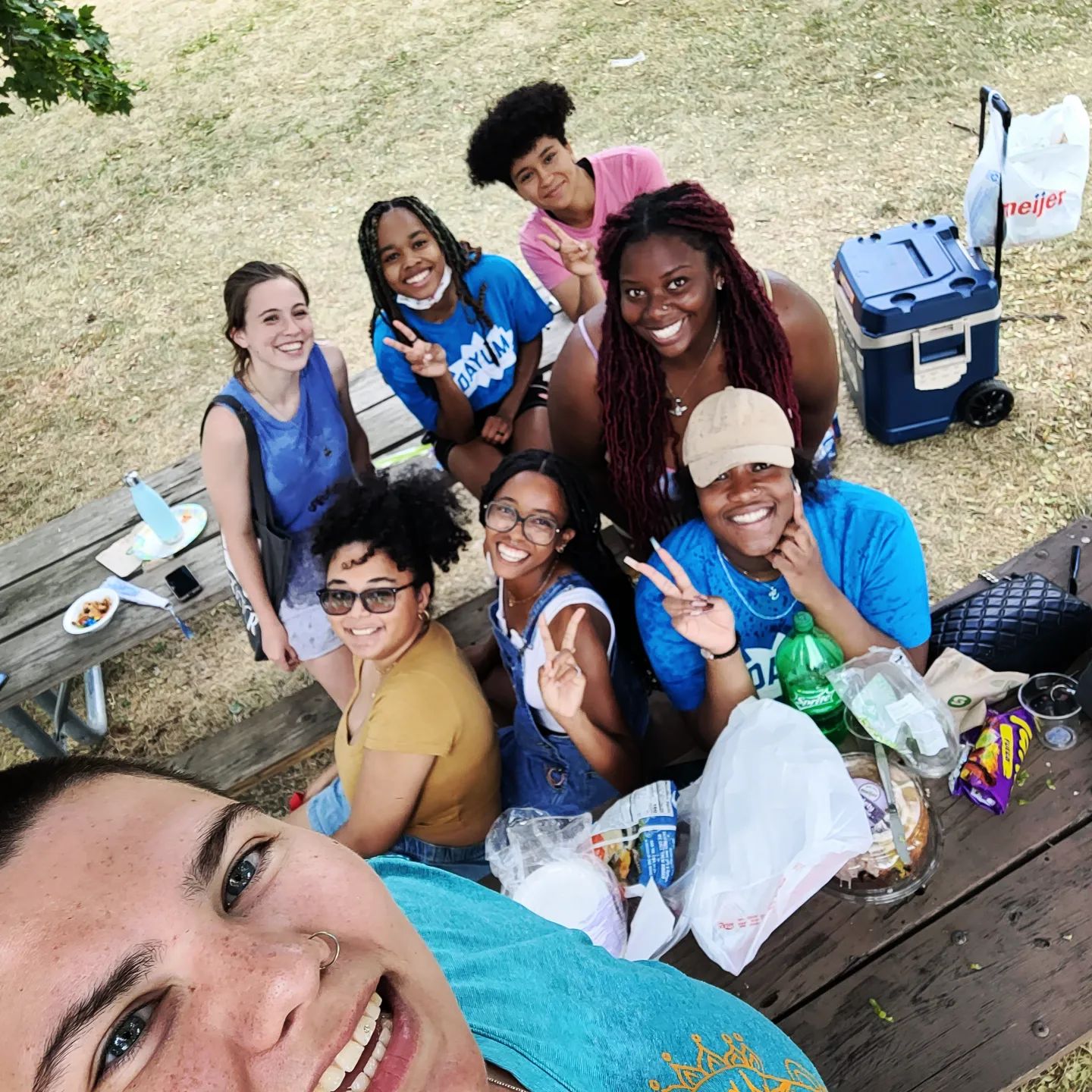“Oh my god I can’t believe my teacher just . . .”
“Y’all see this tweet from the superintendent?”
“When’s winter break start?”
“They just changed up my schedule and I hate it.”
“Why’s the textbook say this? We all know that’s not true.”
As the strategic coordinator (a term students invented to subvert the “executive director” title) for a grassroots youth-run activist organization, Detroit Area Youth Uniting Michigan (DAYUM) my phone constantly buzzes with student concerns, observations, and complaints in our group chat.. . We support students who want to lead campaigns in their schools to change policies or hold school leaders accountable to their students. These issues range from economic justice to climate change to anti-racism — anything that directly impacts youth. Which is everything.
My job is to help students identify which of these issues are systemic and which are personal. Then we create campaigns to make the changes they want to see. I bring in tools gleaned from my background in community organizing. I connect them to partner organizations that work on similar issues and can support us with shaping our demands. My most important role however is to acknowledge and validate their feelings, and remind them that the injustices they experience at school aren’t OK and that they deserve better.
A group of about 10 high school students and I created DAYUM in 2018, after organizing the Detroit branch of the March for Our Lives. We were not funded or paid in the beginning, but we felt that we needed a youth-run organization that wasn’t focused on youth development, electoral politics, or community service. We wanted a base-building organization, one whose only mission is to support youth organizing. That means I go where they want to go — if they’re frustrated with the attendance policy, we work on that. If they react to gun violence in the news, we work on that.
The premise of our work is that young people are leaders today; that they can collectively leverage their power to make change in the present, not just in the future. Like community organizers, our campaigns start with student concerns. Then, we research and analyze before we develop our demands and choose a target. All of this builds on what I see as the natural tendency of young people to question institutions and buck the system.
At the beginning of 2020, we were working on a statewide lobby day uniting young people across Michigan to meet with legislators in our state capital. We called it “Youth Take Over Lansing.”
But in March of 2020, my phone went silent. School had been canceled, nobody knew yet for how long. Most of the young people in our organization were in shock, bouncing between fear for their parents who were essential workers, and anxiety for the statuses of their grades, prom, friends, and graduation.
And when the kids stopped chattering in the group chat, I felt rudderless. We couldn’t meet in person, where I would usually feed them pizza, we’d joke around, and eventually, an idea would surface for a new project or campaign. That is how we’d operated. What else could we do?
I tried messaging in the group chat. “Anyone want to do an Instagram live?”
Crickets.
“Want to meet virtually this weekend?”
Nothing.
And then I broke a grown-up rule. I did something other adults working in education don’t get to do, because it’s (probably rightly) considered inappropriate. I texted them. One at a time, individually. I sent more than 15 texts. All I said was “How are you doing?”
I realized that, despite our close relationships, I hadn’t asked them that yet, not individually. In fact, I don’t think anyone had asked them that, at the time.
I also knew I had to keep it short. The last thing they needed was another paragraph of text on their screen telling them everything we should be doing. I made a choice to focus on them, on their wellness, because as a youth-run organization we could. And, it turned out, we had to.
Slowly, one at a time, sometimes at two in the morning, I started to get responses.
“Terrible. I can’t sleep.”
“I’m OK, but I think I’m failing all my classes.”
“I don’t even know what I’m supposed to be doing.”
“My mom is sick, I’m stuck in my room all day.”
“I’m working all the time, I’m exhausted.”
These young people opening up to me about their mental health made me realize something: My adult priorities (keep our organization running, stay on track to spend our grants, grow our base so we don’t disappear) were completely out of sync with how young people were experiencing the pandemic. My friends in their 20s were having trouble, everyone was, but these kids were deeply struggling. Their silence in the group chat was just one signal of how badly they needed help.
Our organization has come to specialize in youth-led political campaigns, but when it became obvious how badly the pandemic was impacting young people, we pivoted to focus entirely on mental health — first for our members, and then rippling outward. When I asked what they needed, the young people tentatively requested virtual movie and game nights. “I just want to see my friends.” they said. “I miss y’all.”
After a few weeks of consistent social events — at the same time every week, no matter what else was going on in the world — someone mentioned they were bored at home. “I ran out of things to do weeks ago. Now I just stare at my phone.” We brainstormed ideas for outlets that were accessible to young people without transportation or income — coloring, kitchen science experiments, going for a walk.
I don’t remember who suggested it first, but these are community leaders, who never want to keep a good idea to themselves. Our self-care activities inevitably led us to a new project. “What if we make care kits that we can deliver, like to people’s porches?” To my surprise, the young people jumped on this idea — the group chat was busy again. They didn’t just want to entertain themselves, they wanted to take care of others.
“What if we gave them art supplies?”
“Could we include PPE?”
“Does anyone know how to make masks?”
“We should do slime kits!”
“Ooh, stress balls!”
“Card games!”
Our organization rebounded by the end of March with renewed energy and a new mission.
This project eventually became so big that we couldn’t do it by ourselves. We reached out to other local youth programs to join us in this work and together we formed the Covid Youth Taskforce. We distributed more than 200 care kits, with young people themselves fundraising, shopping, creating, and delivering the kits to their peers. While administrators wrung their hands over “learning loss” and test scores, constructing a narrative of young people languishing at home without school to whip them into shape, these young people were applying themselves to a whole new set of circumstances — learning how to respond to crises with compassion, solidarity, and care.
By the time school administrators rallied themselves to take charge, we’d been organizing together for months and grown threefold as an organization. We were ready for the schools’ authoritarian response. Almost immediately, we released the Online Learning Bill of Rights, a list of student-centered expectations for online schooling (see https://alliedmedia.org/post/online-learning-bill-of-rights). Students had rallied to take care of each other through one of the hardest periods in their or their parents’ lives, they weren’t about to accept the harsh, controlling conditions imposed by online school lying down.
The solidarity we’d built across school districts allowed students to recognize and question the inequality of the online learning plans. Why did students in Detroit need to be on screen eight hours a day but their friends in suburban schools had only three hours of synchronous class a day? Why were students being “dress-coded” while sitting in their own bedrooms? It turned out that it was our mutual aid and emergency response projects that laid the groundwork for structural demands on the system.
* * *
Self-evaluation and reflection is an integral part of DAYUM’s practice, it’s how we continue to learn from our organizing in a never ending cycle. In processing these years of pandemic response work together, the young leaders of DAYUM highlighted three important lessons that will inform how we organize going forward. First, as we saw from schools in the spring of 2020, it’s often their own rules and priorities that block traditional institutions from reacting quickly or effectively to crisis moments. Schools in Michigan could have done exactly what we did, only at a much larger scale. Many didn’t , because they did not have the imagination, or governmental support to use resources earmarked for “school” in a different way. Even if it’s deeply educational, even if it’s lifesaving.
Second, just because these traditional institutions refuse to act doesn’t mean those of us in harm’s way can’t. The young leaders noted that we were most successful when we made a purposeful choice to behave as though the government, the adult world, was not going to do much (if anything) to help young people. And in fact, when school administrations did reorient themselves, it was not to provide relief or support but to demand missing homework, prepare for standardized tests, and push students (and teachers) to go “back to normal.”
The third and most important lesson these high school students taught me is that when things seem impossibly hard, the best and easiest way forward is often to reach out to someone else. Inspired by radical organizers who have used mutual aid as a tactic in the past, such as the Black Panthers’ Free Breakfast Program and the water warriors here in Detroit, they were the first to check on each other, share resources, and empathize with their differing struggles. Even from the bottom of what felt like an endless pit of despair, their relationships made them stronger together.
We often think we have to choose between “individual” and “systemic” responses to crises. DAYUM youth have proven that this binary, like many binaries Gen Z is challenging, is not as simple as it at first seems. It was our seemingly “individual” efforts that built the foundation for systemic demands. And it was our systemic critiques of schooling that allowed us to deprioritize academics at the height of the crisis.
It’s important to take stock of what we’ve learned from the unprecedented disruption in schooling brought about by Covid. As our world faces increasing disasters from capitalism, climate change, and white supremacy, we must ask ourselves how we will respond next time. What if our schools had taken a lesson from their students and prioritized rest, resource sharing, safety, and relationships?
Just as workers need unions, young people need to be organizing as students to make collective demands on the system as well as to meet their needs in an emergency. Adults can help by validating their feelings, helping them to analyze their concerns, and acting in solidarity as they develop and push forward demands. In short, we need to be organizers, and we need to see young people as organizers too.
In our 2022 State of the Youth address, DAYUM’s chair responded to Michigan Gov. Gretchen Whitmer’s appeal to “Believe in Michigan.” She challenged Gov. Whitmer to do more to support young people, to earn their trust. Reflecting on two years of youth-led pandemic response work and advocacy she said, “I don’t believe in Michigan, but I do believe in Michigan youth. Why do we believe in ourselves? Because who else is going to?”


